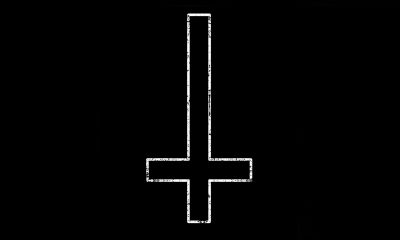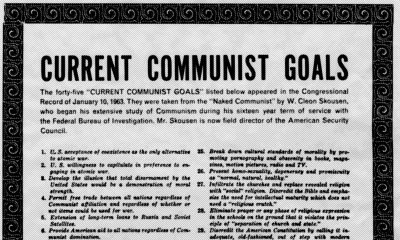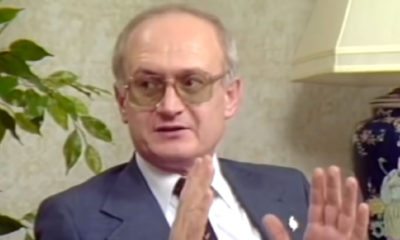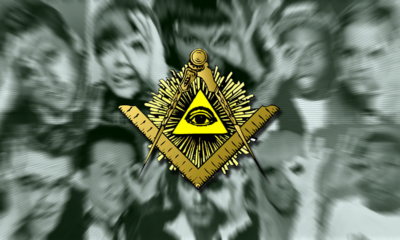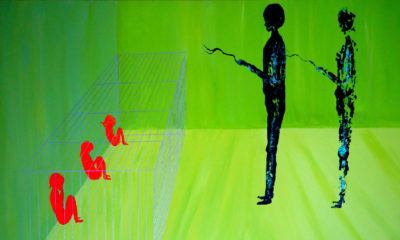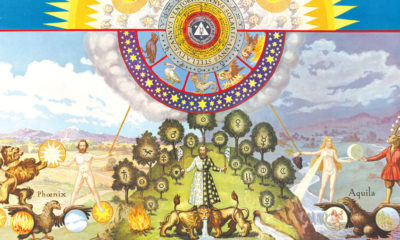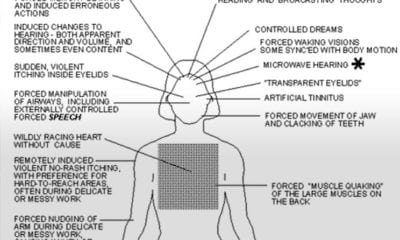Hidden Knowledge
Aleister Crowley: His Story, His Elite Ties and His Legacy
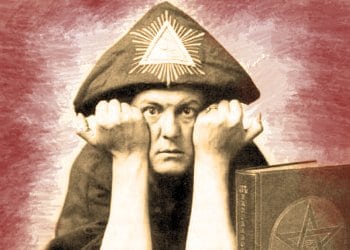
The man called “Great Beast 666″ and dubbed by the press as the “Wickedest Man in History” was more than a theatrical occultist: Aleister Crowley is at the heart of one of the most influential movements of the 20th and 21st centuries. He also had ties with some of the world’s most powerful figures, even working with the British Intelligence Agency MI-5. This article describes the life and works of occultist Aleister Crowley and looks at his ties with the world elite which facilitated the propagation of the Thelema.
Although he is considered to be the most influential occultist of the 20th century and was recognized by the BBC as the 73rd “greatest Briton of all time”, most people have never heard of Aleister Crowley. The English occultist, mystic, and ceremonial magician is incredibly popular in some circles (occultists, artists, celebrities, etc.) but completely unknown to the average person. And why should he be known? What did he accomplish? Simply put, he foreshadowed the radical philosophical change that would sweep the Western civilization during the 20th century. By founding the philosophy of Thelema and announcing the coming of a New Aeon, Crowley did not only formulate the major philosophical precepts of the 21st century, he was part of the Illuminist motor that promoted it.
Because of Crowley’s sexual rituals, drug consumption and dabblings in Black Magick (he introduced the letter “k” at the end of “magic” to differentiate it from the entertainment kind), Crowley was maligned and heavily criticized by the press during his lifetime. However, declassified documents have since revealed that the “Great Beast 666″ led a double life: Crowley apparently maintained ties with the British Government and worked with the British intelligence and high-ranking members of the American Government. The O.T.O.–the secret society he popularized–held within its ranks some of the most influential people of the time, who in turn used their power to further the advancement of its main philosophy: the Thelema.
His Youth

Young Crowley
Crowley was born to a wealthy and religious family. His parents were part of the Exclusive Brethren, a conservative faction of the Christian denomination called the Plymouth Brethren. His father, a traveling preacher for his sect, was particularly devout and was said to read a chapter from the verse to his wife and son every day after breakfast. [1. Lawrence Sutin, “Do What Thou Wilt: A Life of Aleister Crowley] While Crowley maintained a good relationship with his father, he despised his mother, who described him as “the beast” – a name he later adopted as his life-long moniker.
After losing his father to lung cancer at age 11, Crowley inherited the family fortune and went on studying English literature at Trinity College in Cambridge. It is during those academic years that Crowley began renouncing and even rebelling against his Christian background. He seriously questioned the Bible, partook in sexual activities with local girls and prostitutes and developed an acute interest in occultism. Another symbolic step towards his self-affirmation was his name change from Edward Alexander to Aleister. Here’s an excerpt from his autobiography describing the reasons behind his name change:
“For many years I had loathed being called Alick, partly because of the unpleasant sound and sight of the word, partly because it was the name by which my mother called me. Edward did not seem to suit me and the diminutives Ted or Ned were even less appropriate. Alexander was too long and Sandy suggested tow hair and freckles. I had read in some book or other that the most favourable name for becoming famous was one consisting of a dactyl followed by a spondee, as at the end of a hexameter: like Jeremy Taylor. Aleister Crowley fulfilled these conditions and Aleister is the Gaelic form of Alexander. To adopt it would satisfy my romantic ideals. The atrocious spelling A-L-E-I-S-T-E-R was suggested as the correct form by Cousin Gregor, who ought to have known better. In any case, A-L-A-I-S-D-A-I-R makes a very bad dactyl. For these reasons I saddled myself with my present nom-de-guerre—I can’t say that I feel sure that I facilitated the process of becoming famous. I should doubtless have done so, whatever name I had chosen.” [2. Aleister Crowley, The Confessions of Aleister Crowley: An Autohagiography]
Perhaps Crowley’s most significant experiences of his youth were his homosexual relations which, according to his later biographer Lawrence Sutin, led him to an “encounter with an immanent deity”. This triggered in him a great interest in occultism, secret societies and, more specifically, what he will later call Sex Magick.
Secret Societies
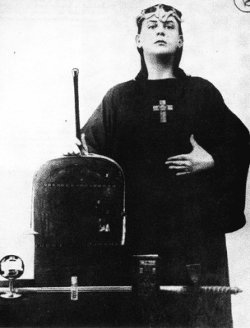
Crowley in magician regalia
In his late twenties, Crowley joined many esoteric groups where he was either admired and rose high in the ranks or despised and expelled. Inspired by Arthur E. Waite’s book, The Book of Black Magic and of Pacts, Crowley joined the Hermetic Order of the Golden Dawn–known as the “Great White Brotherhood” –in 1898. This secret society held within its membership elite and highly influential members of society. There he was introduced to ceremonial magic and the ritualistic usage of drugs.
In 1899, he reportedly became a member of the Old George Pickingil witch coven. However, he was not welcomed for long as a result of his irresponsible attitude and his inclinations toward homosexuality (which was shocking at that time, even to witches). The priestess of his coven later described him as “a dirty minded, evilly-disposed and vicious little monster!” [3. Rosemary Ellen Guiley, The Encyclopedia of Witches and Witchcraft]
Crowley also became a high-ranking Freemason, joining several lodges and acquiring several Masonic degrees. In his autobiography, Crowley described his attainment of the 33rd (and last) degree of the Scottish Rite in Mexico:
“Don Jesus Medina, a descendant of the great duke of Armada fame, and one of the highest chiefs of Scottish Rite free-masonry. My cabbalistic knowledge being already profound by current standards, he thought me worthy of the highest initiation in his power to confer; special powers were obtained in view of my limited sojourn, and I was pushed rapidly through and admitted to the thirty-third and last degree before I left the country.” [4. Op. Cit. Crowley]
With the help of prominent author and Freemason John Yarker, Crowley obtained other Masonic degrees including the 3° In France by the Anglo-Saxon Lodge No. 343, 33° of the irregular ‘Cerneau’ Scottish Rite and 90°/95° of the Rite of Memphis/Misraim. [5. Op. Cit Sutin] According to the United Grand Lodge of England however, whose recognition is generally considered the standard for Masonic validity, none of these Masonic bodies were considered regular and he was never considered an official Freemason.
“The Book of the Law”, the Thelema and the Aeon of Horus
In 1904, Crowley and his new wife Rose visited Egypt for their honeymoon. It is during this trip that he wrote his most famous book Liber Legis, The Book of the Law, which would become the cornerstone of his life.
According to his own account, Crowley’s wife led him into a museum in Cairo where she showed him a seventh century BCE mortuary stele known as the Stele of Ankh-ef-en-Khonsu (which will be later revered as the Stele of Revealing). Crowley was astounded by the exhibit’s number: 666, the number of the Beast in the Book of Revelation.
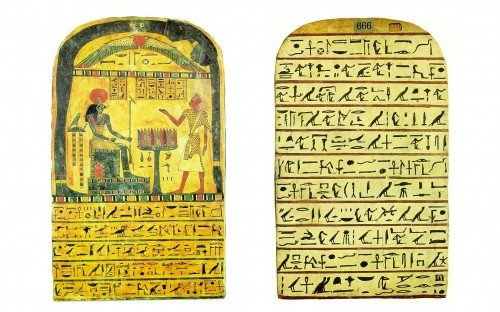
The Stele of Revealing, exhibit number 666.
Later during their stay in Egypt, Crowley and Rose took part in a magical ritual during which he alleges to have received a message from an entity named Aiwass. As a result of this communication, Crowley wrote the first three chapters of the Book of the Law – a mystical text which, he believed, would revolutionize the future of mankind.
“It announced the advent of a new eon in which Crowley has become the priest-prince of a new religion, the Age of Horus. He was to formulate a link between humanity and the “solar-spiritual force, during which the god Horus would preside for the next two thousand years over the evolution of consciousness on this planet. (…)
The message from Aiwaz, whom Crowley understood to be his own guardian angel, convinced him that his mission in life was to give the coup de grace to the Age of Osiris with its moribund appendage, the Christian faith, and build on the ruins a new religion based on the law of the Thelema – Greek for ‘will’.” [6. Peter Tompkins, The Magic of Obelisks]
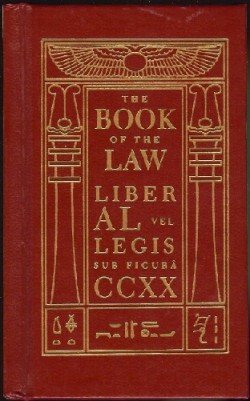
Cover of the Book of the Law
“Had! The manifestation of Nuit.
The unveiling of the company of heaven.
Every man and woman is a star.
Every number is infinite; there is no difference.
Help me, o warrior lord of Thebes, in my unveiling before the Children of men!”– The opening lines of the Book of the Law
“By his adepts, the Book of the Law was described as containing occult formulae of cosmic scope, “some openly expressed, some veiled in the most complex web of qabalistic ciphers ever woven into a single text.” Nor was it just a piece of “automatic writing,” said Crowley, but a clear cut message from an intelligence of superhuman power and knowledge, some extraterrestrial transcendental source, “one of the real hidden masters who would thereafter manifest to him.” [7. Ibid.]
According to Crowley’s protégé Kenneth Grant, anyone possessing the capacity for understanding the language of symbolism “will be staggered with the accuracy of the summary of the spirit of the eon”. [8. Op Cit. Thompson] In other words, the same way the Bible ruled over Western Civilization during the past two millenniums, the Thelema would describe the spirit of the next two thousand years.
“In the Aeon of Horus the dualistic approach to religion will be transcended through the abolition of the present notion of a God external to oneself. The two will be united. “Man will no longer worship God as an external factor, as in Paganism, or as an internal state of consciousness, as in Christianity, but will realize his identity with God.” The new Aeon of Horus, based on the union of the male and female polarities, will involve the magical use of semen and ecstasy, culminating in an apotheosis of matter – “in the realization of the old Gnostic notion that matter is not dual but one with the Spirit” — symbolized by the androgynous Baphomet of the Templars and the Illuminati.” [9. Ibid.]
The Book of the Law became the basis of Thelema, which revolved around three key philosophical ideas:
1- Do what thou wilt shall be the whole of the Law;
2- Love is the law, Love under will;
3- Every man and every woman is a star.
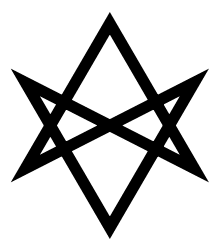
The unicursal hexagram, main symbol of the Thelema
It is widely believed that the saying “Do What Thou Wilt” means “do what you want”, therefore describing an egoistic quest for instant gratification and pleasure. However, initiates of the philosophy disagree with this description of the axiom as they believe it is meant to be interpreted on a metaphysical level. Thelema is Greek for “The Will”. The main aim of this philosophy is the realization of one’s True Will, which is described as one’s “higher calling” or purpose in life, regardless of ethical or moral barriers.
“There are no “standards of Right”. Ethics is balderdash. Each Star must go on its own orbit. To hell with “moral principle”; there is no such thing.” [10. Aleister Crowley, The Old and New Commentaries to Liber AL]
Crowley incorporated these teachings into his newly-founded A.’. A.’. (Argenteum Astrum or the Silver Star), a magical order meant to be a successor of the defunct Hermetic Order of the Golden Dawn. To generate interest in his order, Crowley also published The Equinox – A Journal of Scientific Illuminism (a term borrowed from Adam Weishaupt’s Order of the Illuminati) where he divulged esoteric rituals and techniques. His later work entitled Book of Lies captured the attention of the head of the Ordo Templi Orienti (O.T.O) Theodor Reuss, who soon made him an initiate and Grand Master of the O.T.O. The reason given for such a recognition: His knowledge of sexual magic.
The O.T.O. and Sex Magick
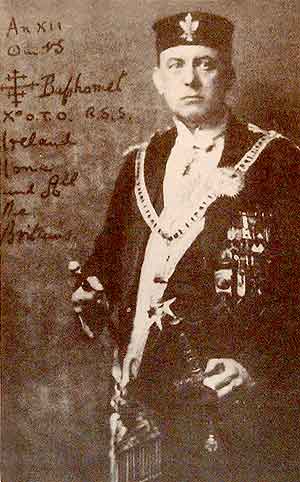
Crowley, known as the “Great Baphomet” of the O.T.O.
The O.T.O’s magical and initiatory system has among its innermost reaches a set of teachings on sex magick. One might even observe that the acronym of this order is rather phallic. Sex magick is the use of the sex act, or the energies, passions or arousals it evokes, as a point on which to focus the will or magical desire in the non-sexual world. It has been equated with the “life force” and the “kundalini”. Through the ritualistic use of sexual techniques, inspired by Tantric schools of the East, the initiate can use the immense potency of sexual energy to reach higher realms of spirituality.
“The order had rediscovered the great secret of the Knights Templar, the magic of sex, not only the key to ancient Egyptian and hermetic tradition, but to all the secrets of nature, all the symbolism of Freemasonry, and all systems of Religion.” [11. Theodor Reuss, Oriflamme]
To set in motion the “occult forces which would result in the illumination of all by 2000 A.D.,” Crowley became convinced that his mission was to “cure the world of sexual repression”. To achieve his goal, he determined to study every detail of sexual behavior and bring every sexual impulse up to the region of rational consciousness. To this end, he experimented with altered states of consciousness, including hashish, cocaine, and opium.
Crowley would eventually introduce (not without protest) the practice of homosexual sex magick into the O.T.O. as one of the highest degrees of the Order for he believed it to be the most powerful formula. [12. Jason Newcomb, Sexual Sorcery] It was clear that Crowley felt the accusations against the original Templars of practicing sodomy and orgies with women had been based in fact, but not understood by their detractors.
Crowley also kept with him a series of “Scarlet Women”: the best known of these was Leah Hirsig, the so-called “Ape of Thoth”. Together they would indulge in drinking sessions, drugs, and sexual magic. It is believed that Crowley made multiple attempts with several of these women to begat a “Magickal child” (see Roman Polanski’s Rosemary’s Baby), none of which reportedly worked. He instead fictionalized his attempts in a book called “Moonchild”, published in 1929.
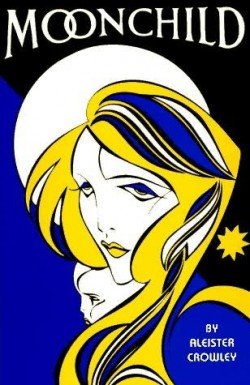
Cover of Moonchild by Aleister Crowley
In the Thelema, the Scarlet woman is equated with Babalon – The Great Mother, the Mother of Abominations of the book of Revelation. Crowley and his protégés would often dabble and experiment with this concept.
Secret Agent 666
As Crowley’s antics were picked up by the press, he soon became infamous as a black magician, a satanist, and drug addict and would be dubbed “The Wickedest Man in the World”. However, unclassified documents revealed that this did not stop the British intelligence from hiring him as an agent. (It was not the first time that the British Crown hired the services of renown occultists; a famous example of such association can be found in the link between John Dee and Queen Elizabeth I.)
The most significant work on the subject of Crowley’s spy career is Richard B. Spence’s Agent 666. Using documents gleaned from British, American, French and Italian archives, Secret Agent 666 sensationally reveals that Crowley played a major role in the sinking of the Lusitania, a plot to overthrow the government of Spain, the thwarting of Irish and Indian nationalist conspiracies, and the 1941 flight of Rudolf Hess.
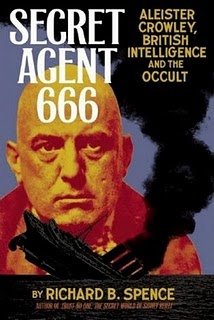
Cover of Spence’s Secret Agent 666
During his research Spence uncovered a document from the U.S. Army’s old Military Intelligence Division supporting Crowley’s own claim of being a spy:
“Aleister Crowley was an employee of the British Government … in this country on official business of which the British Consul, New York City has full cognizance” [13. Richard A. Spence quoting a U.S. military document, Secret Agent 666]
According to Spence:
“Crowley was an adept amateur psychologist, had an uncanny ability to influence people and probably utilized hypnotic suggestion in his undercover work. The other thing he made good use of was drugs. In New York, he carried out very detailed studies on the effects of mescaline (peyote). He would invite various friends over for dinner, fix them curry and dose the food with mescaline. Then he observed and took notes on their behavior. Mescaline was later used by intelligence agencies for experiments in behavior modification and mind control.” [14. Op. Cit. Spence]
During World War II, Crowley became editor of a pro-German magazine called The Fatherland, in which he published incendiary, anti-British articles. He later claimed that these writings were so absurd and outlandish that they ultimately helped the cause of the British. Crowley also proposed many ideas to help the allies, most of which were rejected. One of them, while initially dismissed, was later implemented. This involved dropping occult pamphlets on the German countryside that predicted dire outcome for the war and depicted Nazi leadership as Satanic. His expertise in communications, propaganda and the management of public opinion would be used to make his Thelema a major force in today’s popular culture.
Important Protégés
As head of the O.T.O in California, Crowley tutored many individuals who had a great impact on American Society. One of them is Jack Parsons.
Jack Parsons
Jack Parsons, was an American rocket propulsion researcher at the California Institute of Technology. He was one of the principal founders of the Jet Propulsion Laboratory and the Aerojet Corp. His rocket research was some of the earliest in the United States, and his pioneering work in the development of solid fuel and the invention of JATO units for aircraft was of great importance to the start of humanity’s space age. The noted engineer Theodore von Kármán, Parsons’s friend and benefactor, declared that the work of Parsons and his peers helped usher in the age of space travel. In fact, the Parsons crater on the dark side of the moon is named after him.
“He (Jack Parsons) has been described as ‘the one single individual who contributed the most to rocket science’ and as an individual ‘who traveled under sealed orders from the US Government’” [15. Michael A. Hoffman II, Secret Societies and Psychological Warfare]
Behind closed doors, Parsons was deeply steeped in occultism and became a prominent member of the O.T.O., where he partook in rather extreme sex magick rituals:
“Among Parsons’ many sex partners was that of his own mother (their incestuous encounters were filmed). Both mother and son engaged in bestiality and both appear to have been among that species of psychotic who can function normally in public and achieve positions of authority over others.” [16. Ibid.]
In 1942, Parsons was appointed as head of the Agapé O.T.O. Lodge by Aleister Crowley. Like Crowley, Parsons was obsessed with the idea of creating a “magickal child” with Babalon or the Scarlet Woman.
“The purpose of Parson’s operation has been underemphasized. He sought to produce a magickal child who would be a product of her environment rather than of her heredity. Crowley himself describes the Moonchild in just these terms. The Babalon Working itself was preparation for what was to come: a Thelemic messiah.” [17. Richard Metger, John Whiteside Parsons: Anti-Christ Superstar]
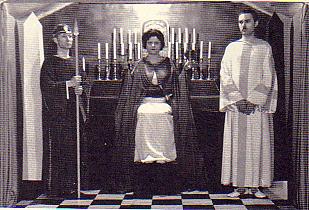
Parsons with fellow members of Agape Lodge.
There was no clear separation between Parson’s professional and occult lives. In fact, he was known to recite Crowley’s poem Hymn to Pan before each rocket test.
Thrill with the lissome lust of the light,
O man! My man!
Come careering out of the night
Of Pan! Io Pan!
Io Pan! Io Pan! Come over the sea
From Sicily and from Arcady!
Roaming as Bacchus, with fauns and pards
And nymphs and satyrs for thy guards,
On a milk-white ass, come over the sea
To me, to me,
Come with Apollo in bridal dress
(Shepherdess and pythoness)
Come with Artemis, silken shod,
And wash thy white thigh, beautifal God,
In the moon of the woods, on the marble mount,
The dimpled dawn of the amber fount!
Dip the purple of passionate prayer
In the crimson shrine, the scarlet snare,
The soul that startles in eyes of blue
To watch thy wantonness weeping through
The tangled grove, the gnarled bole
Of the living tree that is spirit and soul
And body and brain – come over the sea,
(Io Pan! Io Pan!)
Devil or God, to me, to me,
My man! My man!
Come with trumpets sounding shrill
Over the hill!
Come with drums low muttering
From the spring!
Come with flute and come with pipe!
Am I not ripe?
I, who wait and writhe and wrestle
With air that hath no boughs to nestle
My body, weary of empty clasp,
Strong as a lion and sharp as an asp –
Come, O come!
I am numb
With the lonely lust of devildom.
Thrust the sword through the galling fetter,
All-devourer, all begetter;
Give me the sign of the Open Eye,
And the token erect of thorny thigh,
And the word of madness and mystery,
O Pan! Io Pan!
Io Pan! Io Pan Pan! Pan Pan! Pan,
I am a man:
Do as thou wilt, as a great god can,
O Pan! Io Pan!
Io Pan! Io Pan Pan! I am awake
In the grip of the snake.
The eagle slashes with beak and claw;
The Gods withdraw;
The great beasts come, Io Pan! I am borne
To death on the horn
Of the Unicorn.
I am Pan! Io Pan! Io Pan Pan! Pan!
I am thy mate, I am thy man,
Goat of thy flock, I am gold, I am god,
Flesh to thy bone, flower to thy rod.
With hoofs of steel I race on the rocks
Through solstice stubborn to equinox.
I rave; and I rape and I rip and I rend
Everlasting, world without end,
Mannikin, maiden, maenad, man,
In the might of Pan.
Io Pan! Io Pan Pan! Pan! Io Pan!– Aleister Crowley’s “Hymn to Pan”
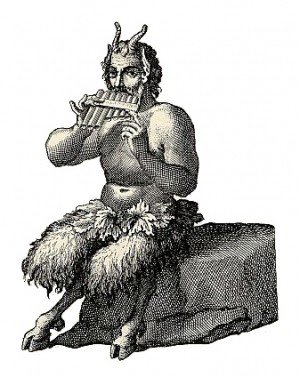
Pan
Parson later associated with an individual who would become hugely influential: L. Ron Hubbard, the man who would establish the Church of Scientology.
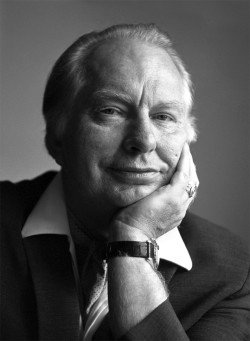
L. Ron Hubbard
Parsons took a great liking to Hubbard, who was then a U.S. Navy Captain and initiated him to the secrets of the O.T.O.
“In a 1946 communiqué to Crowley, Parsons wrote: ‘About three months ago I met (US Navy) Capt. L. Ron. Hubbard…Although Ron has no formal training in Magick, he has an extraordinary amount of experience and understanding in the field…He is the most thelemic person I have ever met and is in complete accord with our principles. He is also interested in establishing the New Aeon…We are pooling our resources in a partnership that will act as a limited company to control our business ventures.” [18. Ibid.]
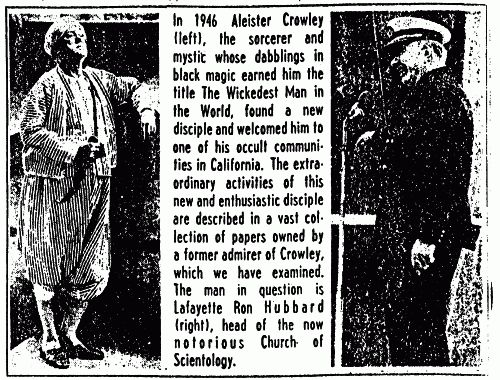
A portion of a 1969 article on the link between Hubbard and Crowley.
Hubbard’s Church of Scientology is today an extremely influential and well-funded sect that boasts within its ranks more than 8 million members, including high-profile celebrities like Tom Cruise, Will Smith, John Travolta and Lisa Marie Presley.
Popular Culture
Although Crowley died nearly penniless, fighting a heroin addiction, his legacy is nevertheless nothing less than colossal. Crowley’s impact on today’s popular culture is noticeable on many levels, whether it is through direct references to his persona or through Thelema-inspired works.
The most obvious examples of Crowley’s influence on popular culture are the references made by the rock stars who were enamored with his persona and philosophy such as the Beatles and Jimmy Page.
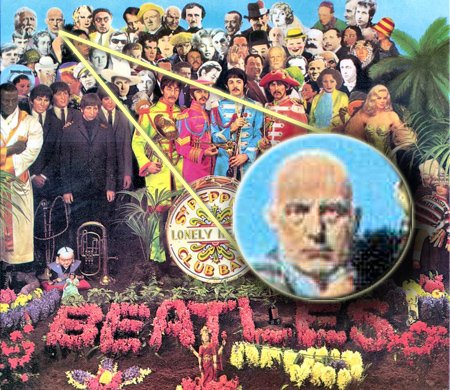
Crowley on the Beatles’ Sgt. Pepper’s Lonely Hearts Club Band album cover
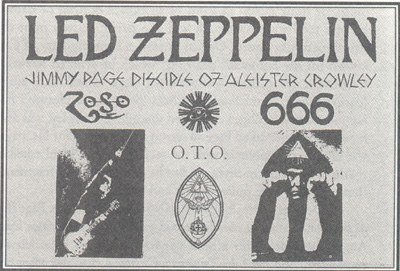

Jay-Z wearing a shirt with Crowley’s most famous saying: “Do What Thou Wilt”
Crowley also inspired numerous movie characters including Le Chiffre – James Bond’s arch-villain in Ian Fleming’s Casino Royale and Satanist witch Adrian Marcato in Rosemary’s Baby. Today, references to Crowley and his Thelema can be found in odd places such as the anime Yu-Gi-Oh! where one of the characters of the series is named Alister in honor of him. This character bears on his forehead “The Seal of Orichalcos”, which is a carbon-copy of Crowley’s unicursal hexagram.
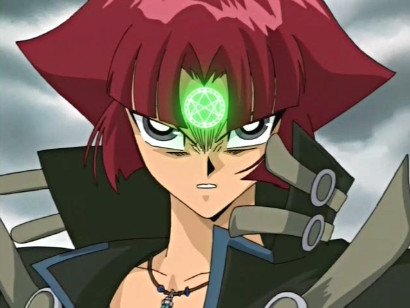
Alister bearing the unicursal hexagram on his forehead.
Beyond these direct references, an astute analyst can detect the influence of Crowley’s Thelemic philosophy and his vision of a New Aeon in countless mass media products. In fact, prominent members of the O.T.O. were (and still are) heavily involved in the production of Hollywood movies, embedding within their plots Thelemic tenets. Science fiction is a favored genre to expose viewers to predictive programming.
“OTO initiates authored mass market stories, especially science fiction, with subliminal, occult themes published in popular books and magazines. Among the most influencial of these were Robert Heinlein’s Stranger in a Strange Land, A.H. White’s Rocket to the Morgue and the aforementioned Arthur C. Clarke’s “The Sentinel” and Childhood’s End. (…)
By means of the newly burgeoning genre of science fiction, the OTO was able to shape the vision of America through predictive programming, which forecasts an “inevitable future,” thereby influencing everything from the architecture of our cities to the design of our automobiles and conception of what constitutes “progress and liberation” in the future. (…)
The OTO’s ability to transform America consisted in the linkage of this brazen lying with science and science fiction, molding media and medicine in their image and likeness and creating a new “Thelemic” religion for the masses.” [19. Ibid.]
In Conclusion
Today, Crowley is regarded as either a misunderstood mystical genius or a depraved charlatan, a prophet for an era of spiritual enlightenment or a Satanic harbinger of the Anti-Christ, an agent for the sexual liberation of mankind or drug-addicted pederast. Were his spiritual visions true or did he con thousands of followers? Answering this question today is practically irrelevant. As a youth, Crowley wished to become a celebrity and to change the course of history and, in his own way, he accomplished both objectives. Not only did his peculiar character make him something of a cult icon, his philosophic and esoteric works are today a major force influencing mainstream culture, values, and spirituality.
Unlike most historical figures who lose their relevancy as the years go by, Crowley’s influence is steadily increasing in the 21st century. This is not only a result of luck or natural evolution, however. Crowley and his O.T.O. maintained ties with high-level members of the British and American governments, as well as with influential figures in science, law, and culture. The world’s elite, predominated by Illuminist values, are in perfect accord with Crowley’s Thelema. These connections facilitated the dissemination and acceptance of his works in popular culture. Crowley did not only predict society’s abandonment of traditional religions and the embrace the Aeon of Horus, he was part of the motor that made these changes happen. His vision of a New Aeon also coincides with the Illuminati’s age-old plan for a secular world order ruled by an “enlightened” elite. The wording might be different, but the hermetic philosophical background is the same. Let’s say that Crowley and the Establishment see “eye to eye” on the subject … and this eye is the Eye of Horus.
Get an e-mail notification as soon as a new article is published on The Vigilant Citizen.
-

 Latest News1 month ago
Latest News1 month agoThe Controlled Demolition of Diddy
-

 Music Business2 months ago
Music Business2 months agoThe Hidden Meaning of Katy Perry’s Highly Symbolic Performance at the 2024 VMAs
-

 Pics of the Month2 months ago
Pics of the Month2 months agoSymbolic Pics of the Month 09/24
-

 Movies and TV3 weeks ago
Movies and TV3 weeks agoAn In-Depth Look at the Hidden Meaning and Symbolism in “Blink Twice”
-

 Music Business2 months ago
Music Business2 months agoSomething’s Terribly Wrong With Sabrina Carpenter and her Video “Taste”
-

 Movies and TV3 months ago
Movies and TV3 months agoPolitics and Mind Control: Why “The Manchurian Candidate” is More Relevant Than Ever
-

 Pics of the Month2 weeks ago
Pics of the Month2 weeks agoSymbolic Pics of the Month 10/24
-

 Movies and TV1 month ago
Movies and TV1 month agoAn In-Depth Look at the Dark Messages and Symbolism in “Longlegs”


